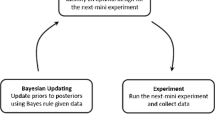Abstract
We conduct an experiment to investigate the degree to which deviations from exponential discounting can be accounted for by the hypothesis of hyperbolic discounting. Subjects are asked to choose between an earlier or later payoff in a series of 40 choice questions. Each question consists of a pair of monetary amounts determined by compounding a given base amount at a constant rate per period. Two bases (8 and 20 dollars), three compounding rates (low, medium and high) and three delays (2, 4, and 6 weeks) are each used. There are also 2 initial periods (Today and 2 weeks) and there are two separate questionnaires, one with lower “realistic” compounding rates and the other with higher compounding rates, typical of those used in previous studies. We analyze the detailed patterns of choice in 6 groups of 6 related questions each (in which the base and rate is fixed but the initial period and delay varies), documenting the frequency of patterns consistent with exponential discounting and with hyperbolic discounting. We find that exponential discounting is the clear modal choice pattern in virtually all cases. Hyperbolic discounting is never the modal pattern (except in the sense that constant discounting is a special case of hyperbolic discounting). We also estimate a linear probability model that takes account of individual heterogeneity. The estimates show substantial increases in the probability of choosing the later option when the compounding rate increases, as one would expect. There are small, sometimes significant, increases in this probability when the delay is increased or the initial period is in the future. Such behavior is consistent with hyperbolic discounting, but can account for only a small proportion of choices. Overall, deviations from exponential discounting appear to be due to error, or to other effects not accounted for by hyperbolic discounting. Principal among these is an increase in later choices when the base is larger.
Similar content being viewed by others
References
G. Ainslie (1975) ArticleTitleSpecious reward: a behavioral theory of impulsiveness and impulse control Psychological Bulletin 82 463–496
G. Ainslie (1985) Beyond microeconomics. Conflict among interests in a multiple self as a determinant of value J. Elster (Eds) The Multiple Self Cambridge University Press Cambridge
Ainslie, G. and Haendel, V. (1983). The motives of will, In E Gotthell, K. Druley, T. Skoloda and H. Waxman, (eds.), Ethologici Aspects of Alcohol and Drug Abuse, Charles C. Thomas, Springfield, IL.
U. Benzion A. Rapoport J. Yagil (1989) ArticleTitleDiscount rates inferred from decisions: An experimental study Management Science 35 270–284 Occurrence Handle10.1287/mnsc.35.3.270
P. Fishburn (1970) Utility Theory and Decision Making Wiley New York
P. Fishburn A. Rubinstein (1982) ArticleTitleTime preference International Economic Review 23 677–694
I. Fisher (1930) The Theory of Interest as Determined by the Impatience to Spend Income and Opportunity to Invest in it Macmillan New York
Hernstein R.J. and Mazur J. (1987). Making up our minds: A new model of economic behavior, The Sciences, Nov–Dec, 40–47.
J. Holcomb P.S. Nelson (1992) ArticleTitleAnother experimental look at individual time preference Rationality and Society 4 IssueID2 199–220
Horowitz, J. K. (1988). Discounting money payoffs: An experimental analysis, Working Paper, Department of Agricultural and Resource Economics, University of Maryland.
T. Koopmans (1960) ArticleTitleStationary ordinary utility and impatience Econometrica 28 287–309
K. Lancaster (1963) ArticleTitleAn axiomatic theory of consumer time preference International Economic Review 4 221–231
G. Loewenstein D. Prelec (1992) ArticleTitleAnomalies in intertemporal choice: Evidence and an interpretation The Quarterly Journal of Economics 107 IssueID2 573–597 Occurrence Handle10.2307/2118482
G. Loewenstein D. Prelec (1993) ArticleTitlePreference for sequences of outcomes Psychological Review 100 IssueID1 91–108 Occurrence Handle10.1037/0033-295X.100.1.91
G. Loewenstein R. Thaler (1989) ArticleTitleAnomalies: Intertemporal choice Journal of Economic Perspective 3 181–193
W. Mischel (1966) ArticleTitleTheory and research on the antecedence of self-imposed delay of reward Progress In Experimental Personality Research 3 85–132
W. Mischel (1974) Processes in delay of gratification L. Berkowitz (Eds) Advances in Experimental Social Psychology Academic Press New York
W. Mischel E. Ebbenson (1970) ArticleTitleAttention and delay of gratification Journal of Personality and Social Psychology 16 329–337
H. Rachlin (1975) Introduction to Modern Behaviorism Freeman San Francisco
H. Rachlin (1974) ArticleTitleSelf-control Behaviorism 2 94–107
R.H. Strotz (1955) ArticleTitleMyopia and inconsistency in dynamic utility maximization Review of Economic Studies 8 165–180
R. Thaler (1981) ArticleTitleSome empirical evidence on dynamic inconsistency Economics Letters 8 201–207 Occurrence Handle10.1016/0165-1765(81)90067-7
Author information
Authors and Affiliations
Corresponding author
Rights and permissions
About this article
Cite this article
Sopher, B., Sheth, A. A Deeper Look at Hyperbolic Discounting. Theor Decis 60, 219–255 (2006). https://doi.org/10.1007/s11238-005-4596-7
Issue Date:
DOI: https://doi.org/10.1007/s11238-005-4596-7




